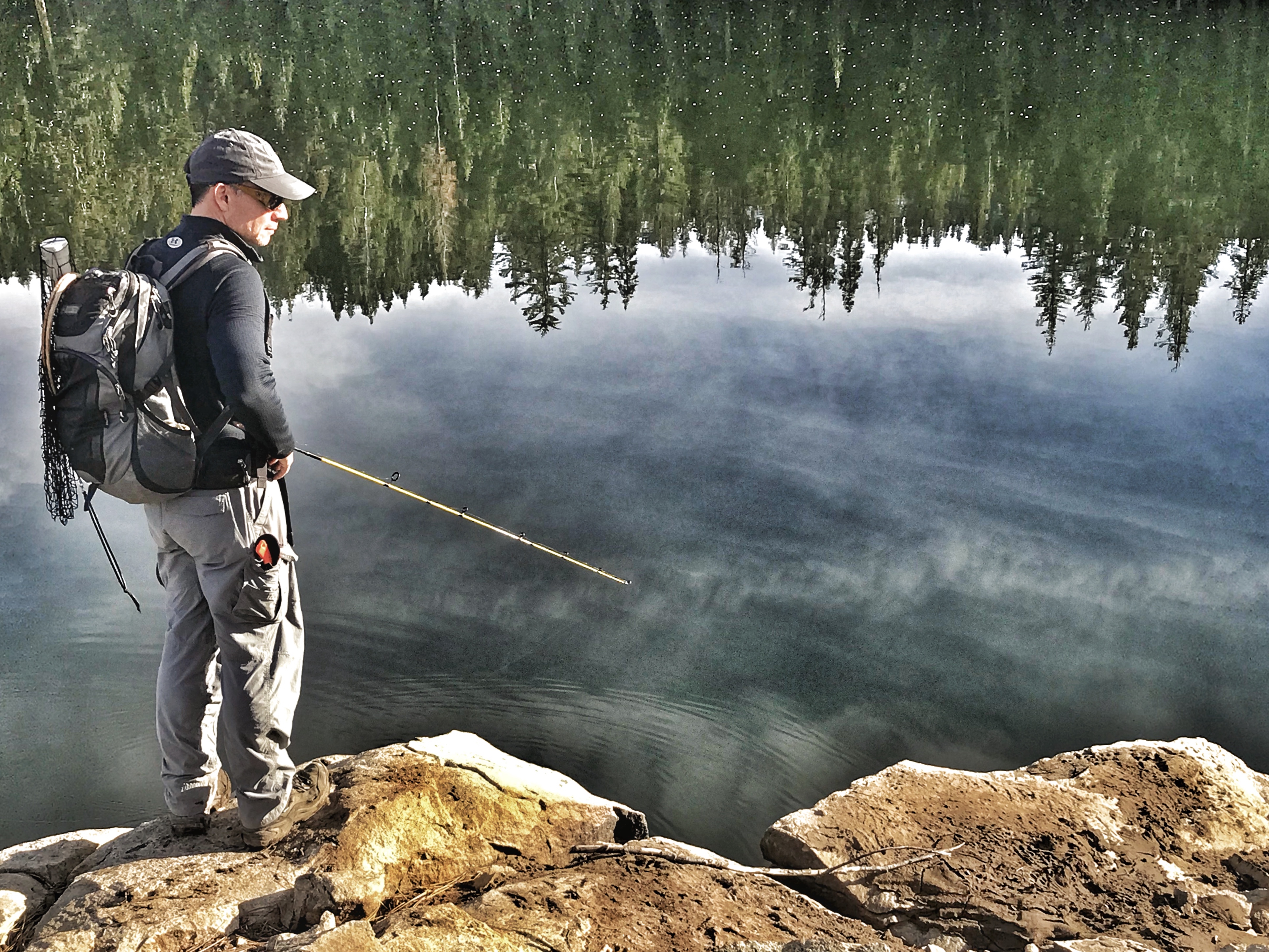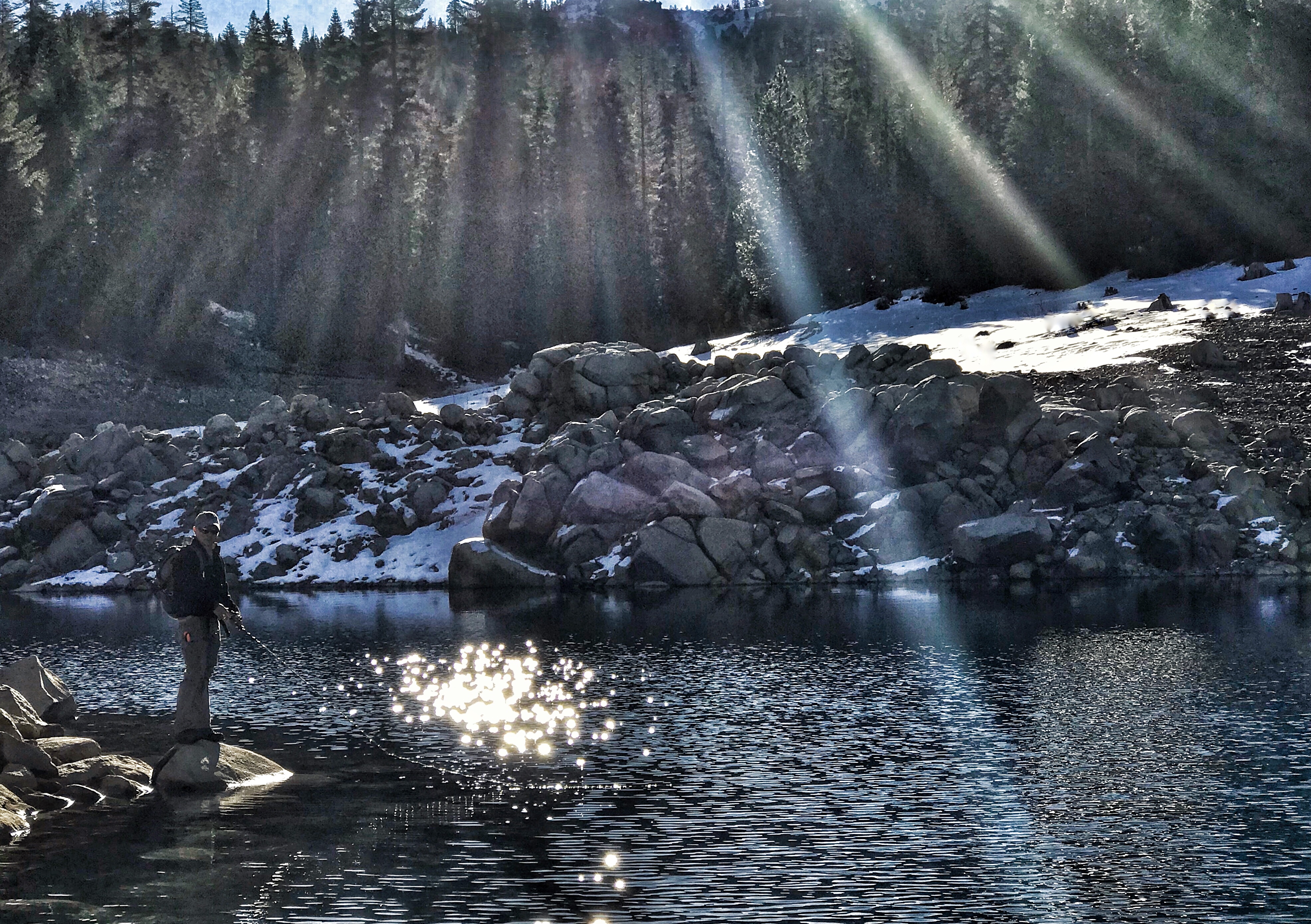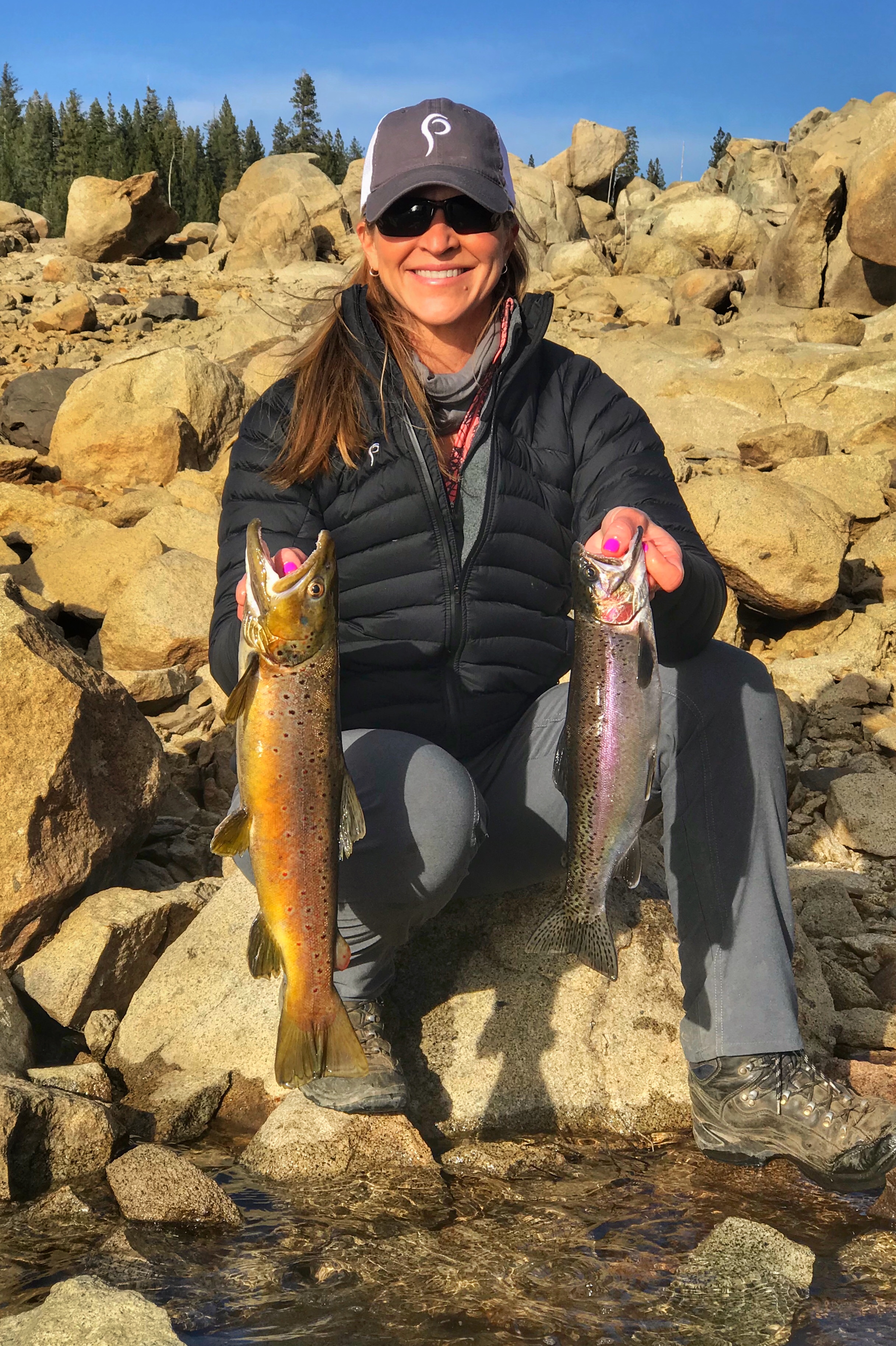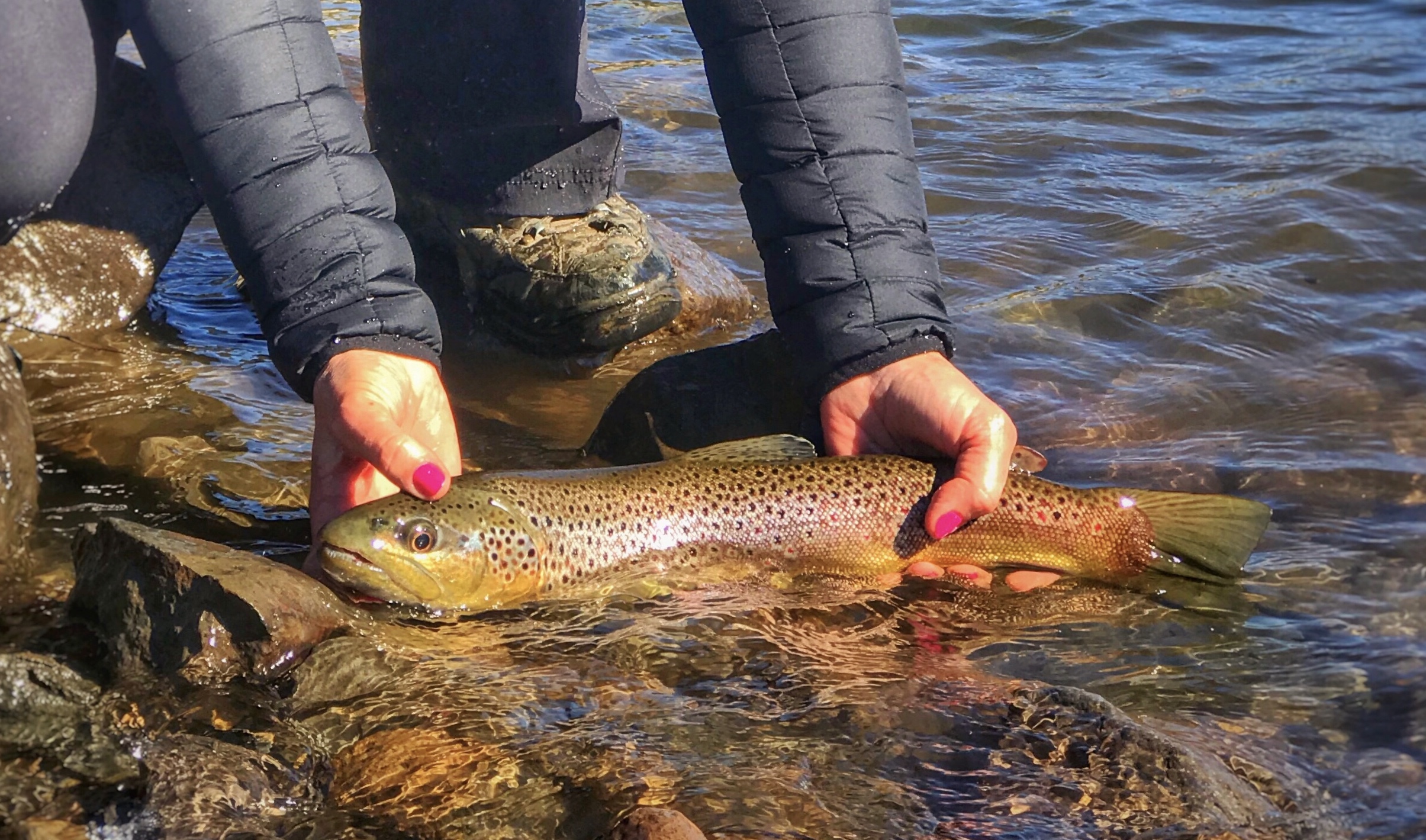Countdown To Trout Opener: Brown Bagging It In The Sierra
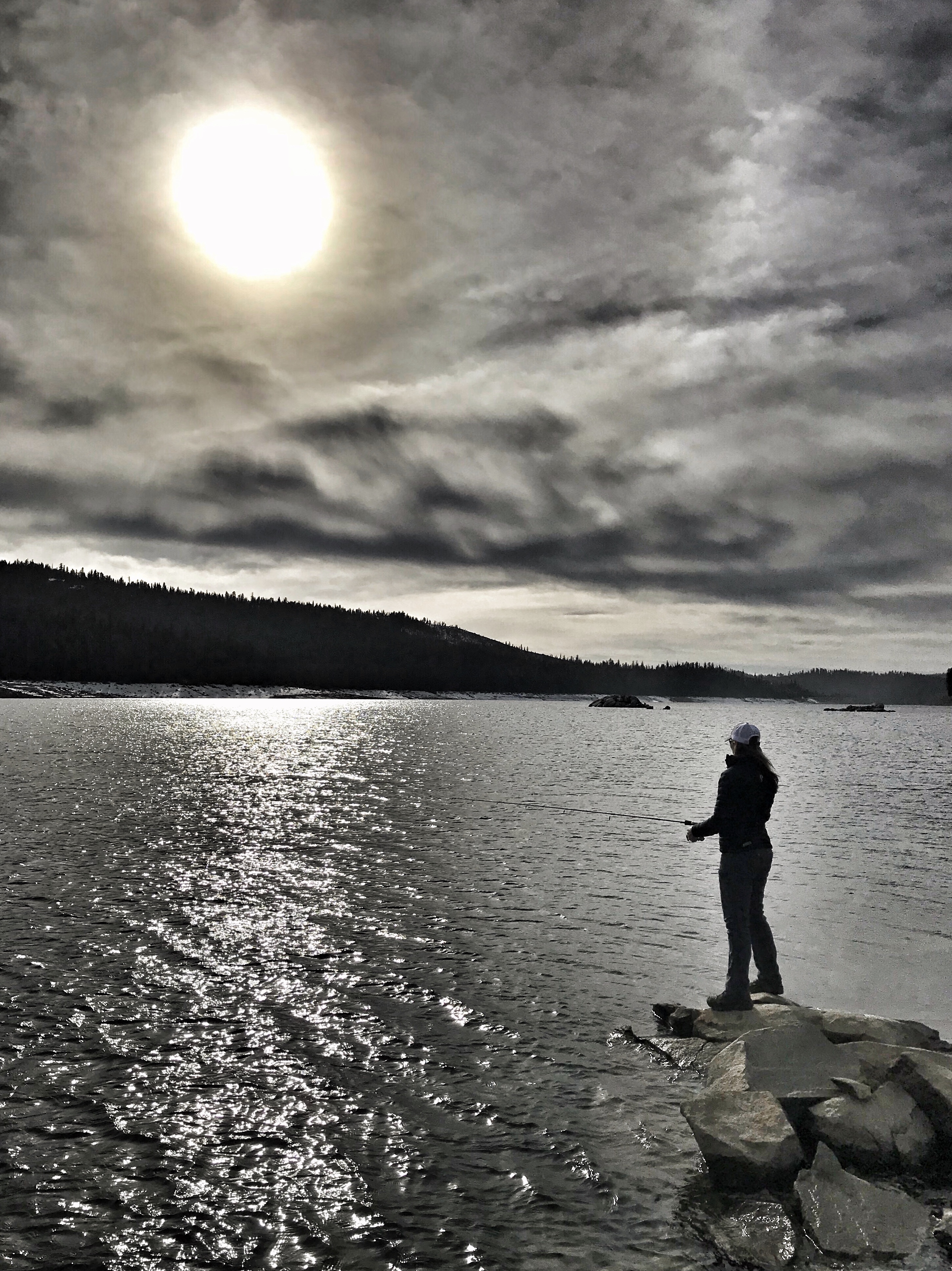
Saturday is the statewide general trout opener. Our April issue commerates “Fishmas Day” and we’ll count down with a story every day this week leading into Saturday’s opening day.
Today: From frowns to browns;
By Nancy Rodriguez
It never ceases to amaze me, the lengths people go to catch a fish. I’m certainly no exception, and this day would drive the point home in a slightly comical and most unpleasant way.
With our hunting season wrapped up, my husband Joe and I decided to take advantage of the delayed winter weather. Since the Sierra snowstorms had been fairly mild to this point, we figured we could make it up to some of our favorite lakes high in the mountains.
After an early-morning wake up and hours spent slipping and sliding down snow- and ice-covered roads, we finally arrived at our destination. We layered up in warm clothes, grabbed our fishing gear and started the journey to our brown trout honey hole. We would be targeting browns for the day.
We ducked and weaved to avoid low-slung, snow-covered pine branches as we hiked, slipped, and stumbled down the hillside and through the forest. After a short hike, the thick trees gave way to open shoreline and I spotted a less-than-ideal obstacle between us and our honey hole: a frigid stream that had to be crossed.
The creek was running fast and I knew the water was going to be seriously painful. Joe and I simultaneously removed our shoes and socks, rolled up our pant legs, looked at each other and shook our heads. We jumped into the knee-high creek. Within seconds, the ice water produced a not-so-pleasant electrical current that pierced our feet, ran up our legs and quickly jumped into our brains as if to ask, What the heck are you doing?!
By the time that registered we were halfway across and our feet were far too numb to feel the river rocks we were scrambling across. Unfortunately, that didn’t lessen the pain signal bouncing around further up our bodies. After what felt like forever – it was probably 30 seconds – the two of us stumbled up the bank on the other side.
We piled up onto the icy rocks and cradled our now frozen, wet feet and just laughed. What we won’t do for a fish!
WITH OUR FEET DRY, our shoes on and steam issuing with every breath, I hiked along the shoreline and constantly scanned for any sign I might be closing in on my destination. With growing anticipating I soon saw it: a submerged rock pile. These always seem to be the perfect ambush spot for predatory browns.
With cautious steps, I made my way out onto the icy rocks, took aim and sent my CountDown Rapala strung on 6-pound-test line arching across the golden sky.
At touchdown, I counted to 20 in my mind. As the lure sank into the dark abyss, I imagined giant browns moving in to investigate. These are the moments that most anglers dream about, and my daily worries seemed to fade away. Then the game began – jerk, jerk, three quick turns of the reel, followed by repeat.
Every 10 feet or so, I would let the lure sink a few feet and start the pattern again. My dancing retrieve was meant to replicate an injured baitfish. I usually test different tempos throughout the day until I find one that works, but for now this is what I was going with.
Just as my tempo slowed and my lure sank again I felt an unmistakable tap telegraph up the line and into my hands. I reeled up the slack, leaned back with the rod and tightened the line as I watched my rod bow under tension. Fish on!
The challenge of landing this fish started as I slowly gained line. The choppy water did little to hide the glowing gold streak below the surface. My adrenaline spiked as he made a mad dash to the surface and leapt into the air and shook the hook with all his might. I prayed I wouldn’t lose him.
My net was submerged and waiting as the battle played out along the shore. I ever so gently scooped him into the black mesh and took a moment to admire his stunning golden colors as they shimmered in the morning sunlight.
WE LOVE TO SPEND late winter and early spring targeting brown trout here in California, and this past season we were fortunate enough to make several cold weather fishing trips happen. We have a kayak that we fish from in warmer temps, but in colder months we prefer to fish from shore. Since brown trout are ambush predators, they like to hold in some pretty specific spots that are easily accessible from the bank. When we head up to the mountain lakes and specifically target browns, the things I concentrate on are location, lure/bait selection, depth of retrieve and retrieval speed and tempo.
The first factor I look for is location. I like to check for submerged rock piles or stumps that may act as a natural ambush spot for brownies. I prefer rocks with a big drop-off to deeper water and dramatic contours. I also tend to snag up less on rocks than I do on stumps, but we do catch plenty of fish right alongside stumps.
They seem to hang out and hide literally right on the edge of structure and wait for the prey to come to them. I usually try to cast far beyond the structure and plan my retrieve to come as close as I can get without hanging up.
The other benefit to shore fishing rock piles is that after your lure sinks, your retrieve will follow the lake’s contour – close to the bottom – all the way back to the bank. From a boat, if you’re casting toward shore and retrieving, your lure leaves the bottom as it is pulled back up toward the boat. This gives you far less time in the strike zone.
OH, YES, THE TRUSTY lures. It seems that most anglers have their “go-to” bait or tackle that they buy season after season. That’s what keeps the tackle companies in business.
Joe and I have invested a lot of time and money to find our go-to lures that have repeatedly worked for brown trout. A few of the lures that have produced nice fish consistently are sinking Rapalas in a brown trout and rainbow trout pattern, as well as Krocodile spoons in silver.
We have even had days where we do a weedless rig on a big nightcrawler – in the same way that bass fishermen rig a rubber worm – and bounce it along the bottom to produce some browns. Every now and then we will pick up a bonus holdover rainbow trout on these lures.
Just like us, fish can be finicky. Some days we want to eat chicken and on others we want steak, so if the browns aren’t hitting we will try whatever else is in our arsenal.
Depth is also a factor in finding the fish. Sometimes it takes several casts to find out the depth they are hanging at. It seems that once you pick up a fish at, let’s say, a 20-second drop in one area, you are likely to hit another one at the same depth working down the shore.
I am no expert, but in my opinion it seems that depth varies day to day, with moon phases, barometric pressure and water temperature as factors. I have caught them at different depths just one week apart with close to the same ambient temperature.
Joe occasionally laughs at me because I will cast over and over in the exact same spot just running different depths until I find the fish, or not. He will have already worked three rock piles down the shore while I’m still at the same area. Sometimes it works and, well, sometimes it doesn’t.
THE MORE I FISH, the more I realize how important the retrieve can be. Many moons ago, I would launch my lure and reel in in the same steady tempo on every cast. Sometimes I would catch a fish and would be ecstatic, but I learned quickly that you need to vary the speed of the retrieve to have better success.
In the winter, the fish can be sluggish and you literally have to slow your tempo so they don’t have to exert much energy to hit your lure. Other times, they are being finicky and you have to give massive erratic movement to even spark their interest.
I usually have good luck reeling at a good tempo, then stopping and letting the lure sink a bit as if the bait is injured. Then I will do a couple of quick jerks and repeat. A lot of the time, they will hit on the drop.
And some days, no matter what you throw or how you retrieve, it just doesn’t come together. That’s why it’s called fishing and not catching.
NEAR THE END OF this particular fishing day, Joe and I had caught and released nine browns that averaged 16 inches and going up to 20 inches. We had one shallow, stump-laden cove to work around before attempting the stream crossing again.
As we neared the edge of the water, the stumps loomed hauntingly below the surface. A small ripple broke the surface 20 feet out and disrupted the mountains’ reflection on the glassy water. Joe took aim and sent his rainbow trout-patterned CountDown Rapala well past the ripple.
Joe did a high-speed retrieve just below the surface until the lure was in the place the ripple had been. Once there, he let it drop two seconds and twitched it twice. Slam! Fish on!
This square-tailed trophy was the biggest fish of the day. The drag screamed as line peeled off the reel with each run. It was nerve-wracking. Soon the fish grew tired and started to parallel the shoreline. Now only 15 feet away, we could see it was a monster 24-plus-incher!
As I removed the net from my pack and prepared to land the fish, I noticed a stump in the direction the trout was heading. Joe quickly shifted the rod from left to right, applied extra hand tension to the spool and leaned back on the rod to turn the fish before it reached the stump.
In an instant, the big brown flicked his tail and ripped drag all the way around the ancient tree. The line now bowed around the stump and the fish was fighting for its life. With one more headshake he was gone.
We both sat there staring at the water in disbelief. A few seconds passed and I looked at Joe and said, “He’ll be bigger next year and you can always look forward to the stream crossing to cheer you up.” With that, we both laughed and started the hike back.
Did I ever mention I hate tree stumps? CS
Editor’s note: Nancy Rodriguez lives in Cool (El Dorado County) with her husband Joe. She is an outdoor enthusiast who loves to fish, hunt and backpack. Nancy is on the Field Staff for Prois Hunting Apparel and a Brand Rep for Rockstarlette Outdoors and enjoys inspiring women to get outdoors.

